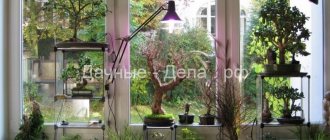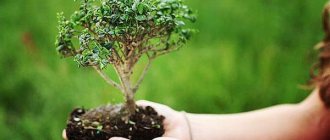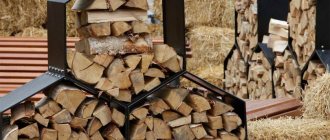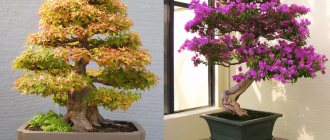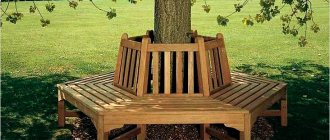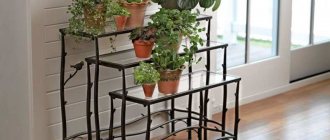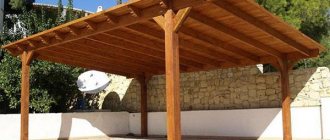Garden bonsai is the technology and art of transforming the shape of a tree and its size, not in a pot, but in the open space of a garden plot. In Japan this style is called niwaki.
Bonsai (Wikipedia) - "tray grown" - is the art of growing an exact replica of a real (sometimes dwarf) tree in miniature.
On the pages of kamsaddeco.com (here and here) methods of shaping pine and spruce by pinching and pruning young shoots, as well as shortening the trunks of large trees have already been discussed.
Examples were given of not only positive, but also negative consequences of modification of coniferous trees.
CONTENT
- Garden bonsai and nivaki: similarities and differences.
- Scots pine garden bonsai, Niwaki styles.
- Garden design elements: garden bonsai, stone paths, artificial boulders and rocks.
Garden bonsai and nivaki: similarities and differences
Methods and principles of forming conifers, together with knowledge of pruning and pinching deciduous plants, make it possible to create a garden bonsai that will correspond to the traditional oriental one.
At the same time, European garden bonsai differs from nivaki both in the technique of plant formation and in the philosophy of the relationship between man and nature: in European bonsai, man dominates nature, and in Eastern bonsai, he harmonizes with it.
As for the technique of pruning pine, the nivaki leaves only three branches in one tier and four at the top if further growth of the tree is planned.
There are no strict restrictions in garden bonsai; you can leave any number of branches depending on your creative plans for the formation and pruning style.
The Japanese believe that garden bonsai is a more complex art compared to niwaki, where there are clear rules.
The art of bonsai: what is it?
This technique is already more than two thousand years old. This art was born in China, became popular in Japan, and later came to Europe. Today, bonsai trees are popular with interior designers as well as landscapers.
This is a miniature tree. Translated, this means “landscape in a bowl” or “tree on the palms.” Creating small replicas of trees is a lot of fun. Therefore, the art of bonsai has become a popular hobby. In Japan, bonsai trees are still grown in private gardens and are passed on from generation to generation.
You can grow bonsai in special flat pots. Use them to decorate office premises, business offices, as well as residential apartments. The tree is grown in special containers in gardens.
Some gardeners grow such trees directly in open ground. If you have never grown bonsai, and you really like such trees, then you can buy bonsai on the website
Growing bonsai trees is a rather lengthy and not entirely simple process. You need to frequently trim the roots of the plant, using different tools to modify the shape of the crown and even the trunk. If you still decide to take a risk and grow such a plant yourself, then we will tell you how to grow bonsai trees.
What is bonsai photo:
Scots pine garden bonsai
The question is often asked: why do they usually give examples of pruning Scots pine and not other plants?
Firstly, shaping pine in the Niwaki style is considered to be the most labor intensive. And, if you learn to work with pine, then it will be even more successful with other plants.
Secondly, Scots pine is the most common, unpretentious and fast-growing tree in all regions.
With it, the results of your work can be seen much earlier than when forming other types of trees.
In Japan, pine also receives great attention from craftsmen and landscape designers.
Bonsai in the garden
Bonsai is an integral element of Japanese traditions, which involves the transformation of initially large trees into dwarf plants. Japanese-style interiors are decorated with this type of decor, but bonsai can also be grown in your own garden, and this can actually be done without the help of professionals.
Tree selection
For the role of bonsai, you can choose any tree that tolerates the existing climatic conditions well. If we talk about the decorative component, then the Japanese flavor can be most clearly conveyed by a miniature pine tree. It is better to choose its rock type, which itself is not large in size.
Other options to consider include spruce, thuja, juniper and even cypress. But the choice is not limited to coniferous trees - you can also use fruit trees. Dwarf apple trees, pears and plums look very impressive. If pruning is done correctly, the trees will produce a harvest.
Subtleties of landing
The bonsai planting technique is aimed at creating conditions in the open ground that are as close as possible to container growth. This is the only way to turn an ordinary tree into a dwarf plant. You should act in stages:
1. Dig a hole and cover it with concrete or cover it with a wide stone. Pour 30-40 cm of soil over the stone layer. Under no circumstances should you use black soil - the soil should be as light and infertile as possible.
2. Plant the tree, after cutting off the roots, in a prepared hole and dig it in. After this, do not touch the plant for 1 year, allowing it to take root.
3. In early spring, cut off 1/4 of the roots by cutting them with a shovel. A year later, do the same and so on every year.
Remember that a tree needs to eat to survive, so you can’t cut off all the roots in a circle!
Crown formation
After the first pruning of the roots, you can begin to improve the appearance of the bonsai. Pruning is carried out once a year, preferably at the end of winter. All large branches and shoots that do not correspond to the desired shape must be removed. They pinch bonsai in the summer, and do this several times in one season in order to achieve the appearance of new shoots. There are 8 main ways to form bonsai, they are presented in the figure:
It is important not only to make the tree dwarf, but also to create the illusion of a century-old plant. Even if the bonsai has been growing on the site for only the second year, it should have the appearance of a hundred-year-old baobab. This is quite simple to achieve - just bend the branches to the bottom, then the tree will look more mature. You can implement your plan with the help of a weight tied to each branch.
Niwaki styles
What styles of nivaki exist can be seen in the following pictures.
Historically, nivaki styles were formed based on examples from nature itself. The man borrowed from her everything he liked and tried to repeat in his works.
It should be noted that not all niwaki techniques are suitable for garden bonsai. This is due to the climatic characteristics of Japan, where it is possible to do more severe pruning of pine (more than 50%), since it is guaranteed to produce two growths per year.
You can begin to shape a pine tree at any age and prune it all year round, but it is still better to do this in early spring before the sap begins to flow.
But pinching or cutting annual growths must be done at the end of May - beginning of June, depending on the condition of the pine candles. This was discussed in sufficient detail in the article about pruning and pinching pine.
Basic shape - triangle
It should be noted that first, trimming pine branches should be done so that its shape resembles a triangle. The lower branches should be larger than those growing higher and so on until the very top.
This is done to ensure that all branches are equally well illuminated. Otherwise, those that are constantly darkened will dry out over time and will have to be cut off.
The triangle itself can be inclined, which will give the tree an even greater resemblance to wildlife.
If there are large natural or artificial stones near the trees (more on this later), then the overall appearance of the landscape will resemble a rocky area with prevailing strong winds.
The technique of pruning and pinching coniferous trees was given in the articles on the previously mentioned links. Therefore, we will not dwell on this. The Japanese usually use bamboo sticks to control the bending and direction of branches.
The following photographs show an example of the stages of sequential formation of a young pine, starting with the first pruning and further annual pinching for six years.
In the second photo (after pruning) you can see how many branches of the tree were cut off.
After such a complex operation, the plant suffers and of course it would be nice to help it recover faster.
In this case, growth stimulants are not used, but immunity enhancing stimulants are used. For this purpose, iron chelates with vitamins are suitable, which are used as a top dressing when applied to the crown of the plant.
In the future, you can mulch the soil around the tree with old needles from the forest. Acidification of the soil is quite acceptable. Several examples of long-term processing of plants.
Choosing plants for bonsai technique
You can, if you wish, choose any tree that you like best. If you are growing a tree in the garden, then it is not necessary to create a very tiny copy, because then such a tree will be lost against the background of other plants. For the house, it is better to immediately take initially compact trees, then it will be much easier to give the shape.
The best plants for the garden. You can choose deciduous as well as coniferous trees and shrubs. Remember that deciduous trees will lose their attractiveness in winter. Coniferous trees will look beautiful all year round. Try starting with mountain pine, as this tree is compact in itself. Common spruce, thuja, juniper, and cypress are often grown. Traditional fruit trees will also look good in the garden. In the spring they will simply fascinate with their beauty during flowering. Pay attention to decorative plum, cherry, and apple trees. One of the most popular flowering plants for this technique is sakura.
The best plants for the home. Try rehearsing with ivy. If you spoil the shape by pruning, the plant will quickly recover. Ficus looks impressive in an apartment. Coniferous trees can also beautifully complement your interior. Deciduous trees are also grown at home, but remember, they will definitely shed their leaves in the fall. The plant will need to be placed in a cool place. Linden, chestnut, oak, willow, rowan, and birch are popular deciduous plants for the home.
Bonsai in the garden:
Bonsai tree pot
A simple pot is not suitable for a mini-tree. When choosing a container in which the plant will grow and develop, you need to remember the translation of the word “bonsai” - tree on a tray. A dwarf tree requires a special pot, low and wide, similar to a dish with low sides. Light materials such as plastic are not suitable for the place in which the bonsai will grow - as the plant ages, it gains weight and may fall. Massive containers and bowls for planting a bonsai tree made of clay and ceramics of various shapes can be found in specialized stores.
Is it possible to keep a bonsai tree at home?
According to the teachings of Feng Shui, any living plant affects the energy of the room in which it is located. A mini bonsai tree can even out unstable flows of energy in rooms of complex shape. It can be confidently installed in attic rooms with uneven ceilings and walls, in dark corners far from natural light, next to doors. You can enhance the influence that a bonsai tree has on the atmosphere in your home if:
- charge water for watering plants with precious stones and metals;
- talk to the bonsai and treat it without malice;
- periodically play pleasant classical music for the tree.
Rules of care
The main condition for growing any miniature plants is an abundance of sun. In the shade, the needles will grow too long, distorting the appearance of the bonsai. A lack of light at home can provoke the death of branches. In addition, such a plant does not tolerate drafts at all.
Watering and fertilizing
Bonsai - DIY home care
The tree requires discreet but systematic moisture, preferably in the morning or evening. During initial watering, the container with the plant is placed in a basin of water. Moisture enters the soil through a hole in the bottom and saturates the entire soil. Subsequently, it is moistened with a thin stream from a watering can or by spraying.
Coniferous trees need feeding from April to October. Old bonsai are rarely fertilized. For balanced plant development, complex minerals alternate with organic ones.
Reproduction
Growing bonsai begins with planting. Usually, two methods of cultivating a young tree are used: seed and cuttings. Both methods require patience.
Additionally! Pine seedlings can be purchased at the nursery.
The most suitable method for pine trees is seed, but it takes up to 12-15 years. Pine seeds collected independently in the forest usually germinate 34 weeks after planting.
Helpful information. The formation of Scots pine in bonsai style, its roots, trunk bends and branches by applying wire begins in the second year of growth, and this is likely only with seedlings.
Planting a plant
Transfer
Bonsai transplantation is carried out at the beginning of the spring season, before the buds swell. Experienced gardeners recommend doing this for the first time in the 4-5th year of growth, and later every 2-3 years. During the replanting process, the old soil containing a lot of nutrients should be partially left on the roots. After the first successful transplant, the gardener may think about how to make a bonsai from a pine tree at their summer cottage.
Description and main types
Miniature trees using the bonsai technique are reproductions of plants found in nature. In Japan, growing bonsai is a holistic worldview that combines spirituality and the physical side. In Russia, miniature trees appeared quite recently. Undemanding pine is perfect for creating fancy shapes.
Landing ideas
To grow such a tree with your own hands, an amateur just needs patience and knowledge of how to make a bonsai from a pine tree. The tree is formed artificially according to special rules:
- the trunk should be strong and impressive with a compacted support and a rhizome protruding from the soil;
- There are usually few branches so that they combine with each other, giving the tree its unique appearance;
- They try to give the pine the shape of one of 15 classic samples.
Niwaki
The outline of a pine bonsai should resemble a plant growing in nature. The most important task when growing a tree is to slow down its growth. For growing bonsai, 4 varieties of pine are usually used.
Japanese black
Pinus thunbergii is most often taken as the basis for cultivating a tiny plant due to the uniqueness of its bark, crown density, slow growth, endurance and unpretentiousness. The tree can easily withstand very harsh conditions and can survive even on rocky soil.
Classic plant
Japanese white
Pinus parviflora can be single-stemmed or multi-stemmed. Over time, the branches acquire a grayish-blue tint, and the delicate thin needles with curved tips justify the specific name of the tree. This species is very popular in garden plots.
Mountain
Not too capricious to grow, mountain pine bonsai (mugus) with favorable care is distinguished by a dense crown that allows it to be shaped in a variety of styles. The bark of the young tree is purple in color, and the pine blooms with light purple inflorescences.
Ordinary
Parviflora is the simplest option for domestic lovers. It does not require special conditions, it can easily be formed into the desired appearance. Scots pine bonsai is distinguished by paired yellowish-green needles and scaly brown-reddish bark. It usually has low hanging branches, giving it a graceful shape.
Styles
Planting and growing conditions
Coniferous trees differ from deciduous trees in two periods of annual growth, which are important for the gradual formation of bonsai. The first stage - increasing the length of the branches - occurs in the spring, the second - increasing their thickness - in August. It takes several years for full creation.
DIY bonsai - growing plants at home
The secret to growing a miniature tree is to control root growth as much as possible. To do this, seedlings are placed in low pots. This method allows you to limit the growth of the above-ground part of the plant and obtain the desired size of the seedling. Before planting, the root system is usually dug up and trimmed.
Important! At the bottom of the container you need to place a large stone covered with soil.
Pine bonsai are characterized by strong and developed surface roots (nebari), which reliably hold the tree in the soil.
In the wind
